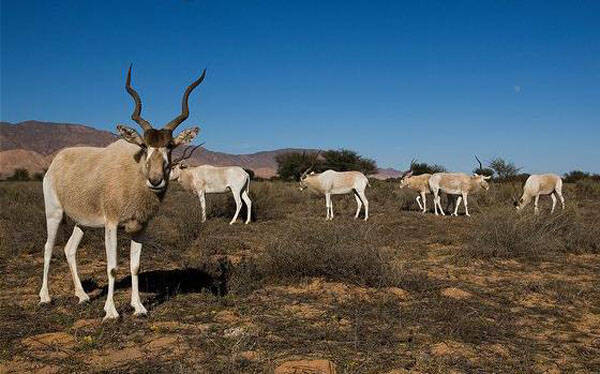Addax nasomaculatus
IUCN
LCBasic Information
Scientific classification
- name:Addax nasomaculatus
- Scientific Name:
- Outline:Ungulata
- Family:Artiodactyla Bovidae Addax
Vital signs
- length:110-130cm
- Weight:60-120kg
- lifetime:About 25 years
Feature
It is large in size and is named after its twisted horns.
Distribution and Habitat
The Addax is found in Gambia, Algeria and eastwards into the Sahara Desert. The species is found in Niger, Chad, Mali and Mauritania.
It lives in large deserts.
Appearance
The Addax is the only species of the Addax genus in the family Bovidae, Artiodactylus order. It is named after its twisted horns. It is large in size, with a body length of 110-130 cm; shoulder height of 95-115 cm; and a weight of 60-120 kg. It has a short neck, shoulders slightly higher than hips, thick limbs, and wide hooves, which are suitable for walking in the desert; the tail is round and thin, 25-35 cm long, with long hair at the end; the winter hair is long and rough, gray-brown, and the summer hair is sandy yellow; there is a large tuft of black hair on the forehead; the eyes are small; both male and female Addax have horns, the male horns can be up to 120 cm long, and the female can be up to 80 cm long. The horns are thin, respectively curved backward and outward and then upward, and slightly flat spirally twisted. This is where the name comes from. The bottom of the hoof is wide and strong, so it can walk on soft sand, which makes them the most adapted antelope to the desert
Details
Addax nasomaculatus (scientific name: Addax nasomaculatus) has two subspecies.

Addax has a strong gregarious nature. It lives in small groups in the wild of Africa and leads a wandering life. The population includes both males and females, ranging from 5 to 20, led by older male addacs, and forages collectively. They live in desert areas and have a strong ability to adapt to the dry desert. They rarely drink water in their lives. They are bulky and run slowly. They are generally active at night and live in low-lying areas dug by themselves during the day. They constantly migrate long distances to find enough food and rarely drink water in their lives. They are active at dawn, dusk and at night. They are bulky and run slowly, making them easy to be hunted by local residents.
Addacs are herbivorous animals that look for rough plants in the vast desert and feed on grass, leaves and other shrubs. The food types are relatively simple. In the Shanghai Zoo in China, the food types provided to them are very rich. The grass types include alfalfa, rye, Sudan grass and other green grasses or hay. Fruits include apples, watermelons, carrots, and nutritionally balanced pellets for herbivores.
In order to pass on their genes and compete for the most mates, wars between male addax are inevitable, both in the wild and in zoos. Addax have a particularly long gestation period of about 10-12 months, giving birth in winter or early spring, with one baby per litter, and mating immediately after giving birth. The baby is completely weaned after one month and can live up to 25 years.

1991 Shanghai Animals The three antelopes, one male and two females, introduced from the United States, initially lived a comfortable life of "polygamy" without "war". With the introduction of a pair of Addax from the Netherlands two years later, the peaceful "war-free" life was broken, and the first "war" for the "throne" began. After a close fight, the American male antelope took advantage of the time and place, defeated the Dutch male antelope, and established the first generation of the American "dynasty", temporarily making the Dutch male antelope bow down. As the population expanded, this war for the "throne" continued every now and then, year after year.
Interestingly, the addax defecate to mark the territory. Only the "king" has a unique posture when defecating, and only the "big king" is qualified to defecate in this unique way. Generally, whether it is the "second king" or the "queen" and other concubines, the addax defecate while walking or standing still, while the "king" defecates with the hind legs squatting, with the anus close to the ground. In this way, the feces pulled out close to the ground will not roll everywhere, but form a "hill" shape, which is very regular, and the feces are pulled in various directions within the range of its activities, this pile, that pile, the purpose is to divide and determine the "country" and "territory" controlled by the "king". The big king not only defecates to mark the territory, but also often rubs the fence, railings, grass and other behaviors with his horns to leave smells to warn "outsiders" not to invade.
Due to poaching, the number of addax in the wild in Africa has become extremely rare, so many zoos have kept addax in captivity in the hope of protecting them. There is a large zoo population in Hannover Zoo in Germany, and animal conservation workers hope to help the wild population gradually recover by restocking these addax populations in some areas of Morocco and Tunisia. The number is rare, with less than 500 in the wild (statistics in 1996).

In September 1991, Shanghai Zoo in China imported one male and two female addax from San Diego Zoo in the United States for the first time. Two years later, a pair of adult addax were imported from Rotterdam Zoo in the Netherlands. After more than ten years of domestication and breeding, the population has expanded to 48. Among them, 13 were sold to brother zoos, 14 died of old age and illness, and there are still 21 in the zoo, which is not a small population.
Listed in the 2008 Red List of Endangered Species of the World Conservation Union (IUCN) ver 3.1 - Critically Endangered (CR).
Listed in the CITES Appendix I protected animals of the Convention on International Trade in Endangered Species.
Listed in Appendix I, Appendix II and Appendix III of the Convention on International Trade in Endangered Species of Wild Fauna and Flora (CITES) 2019 Edition.
Protect wild animals and eliminate game.
Maintaining ecological balance is everyone's responsibility!








